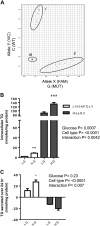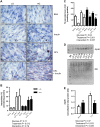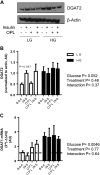Characterization of lipid metabolism in a novel immortalized human hepatocyte cell line
- PMID: 26126685
- PMCID: PMC4572456
- DOI: 10.1152/ajpendo.00594.2014
Characterization of lipid metabolism in a novel immortalized human hepatocyte cell line
Abstract
The development of hepatocyte cell models that represent fatty acid partitioning within the human liver would be beneficial for the study of the development and progression of nonalcoholic fatty liver disease (NAFLD). We sought to develop and characterize a novel human liver cell line (LIV0APOLY) to establish a model of lipid accumulation using a physiological mixture of fatty acids under low- and high-glucose conditions. LIV0APOLY cells were compared with a well-established cell line (HepG2) and, where possible, primary human hepatocytes. LIV0APOLY cells were found to proliferate and express some mature liver markers and were wild type for the PNPLA3 (rs738409) gene, whereas HepG2 cells carried the Ile(148)Met variant that is positively associated with liver fat content. Intracellular triglyceride content was higher in HepG2 than in LIV0APOLY cells; exposure to high glucose and/or exogenous fatty acids increased intracellular triglyceride in both cell lines. Triglyceride concentrations in media were higher from LIV0APOLY compared with HepG2 cells. Culturing LIV0APOLY cells in high glucose increased a marker of endoplasmic reticulum stress and attenuated insulin-stimulated Akt phosphorylation whereas low glucose and exogenous fatty acids increased AMPK phosphorylation. Although LIV0APOLY cells and primary hepatocytes stored similar amounts of exogenous fatty acids as triglyceride, more exogenous fatty acids were partitioned toward oxidation in the LIV0APOLY cells than in primary hepatocytes. LIV0APOLY cells offer the potential to be a renewable cellular model for studying the effects of exogenous metabolic substrates on fatty acid partitioning; however, their usefulness as a model of lipoprotein metabolism needs to be further explored.
Keywords: NAFLD; PNPLA3; hepatocyte; human; triglyceride.
Copyright © 2015 the American Physiological Society.
Figures









References
-
- Abelev GI. Alpha-fetoprotein in ontogenesis and its association with malignant tumors. Adv Cancer Res 14: 295–358, 1971. - PubMed
-
- Adiels M, Westerbacka J, Soro-Paavonen A, Hakkinen AM, Vehkavaara S, Caslake MJ, Packard C, Olofsson SO, Yki-Jarvinen H, Taskinen MR, Boren J. Acute suppression of VLDL1 secretion rate by insulin is associated with hepatic fat content and insulin resistance. Diabetologia 50: 2356–2365, 2007. - PubMed
-
- Ampuero J, Del Campo JA, Rojas L, Garcia-Lozano JR, Sola R, Andrade R, Pons JA, Navarro JM, Calleja JL, Buti M, Gonzalez-Escribano MF, Forns X, Diago M, Garcia-Samaniego J, Romero-Gomez M. PNPLA3 rs738409 causes steatosis according to viral & IL28B genotypes in hepatitis C. Ann Hepatol 13: 356–363, 2014. - PubMed
-
- Angulo P, Lindor KD. Non-alcoholic fatty liver disease. J Gastroenterol Hepatol 17 Suppl: S186–S190, 2002. - PubMed
-
- Anstee QM, Day CP. The genetics of NAFLD. Nat Rev Gastroenterol Hepatol 10: 645–655, 2013. - PubMed
Publication types
MeSH terms
Substances
Grants and funding
LinkOut - more resources
Full Text Sources
Other Literature Sources
Medical
Miscellaneous

